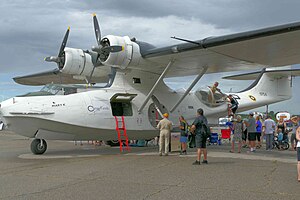No. 162 Squadron RCAF
| 162OspreySquadron RCAF | |
|---|---|
| Active | 1942-1945 |
| Disbanded | 7 August 1945 |
| Country | |
| Allegiance | |
| Branch | |
| Role | Bomber Reconnaissance |
| Part of | Eastern Air Command,RAF Coastal Command |
| Nickname(s) | Osprey |
| Motto(s) | Sectabimur usque per ima. (We will hunt them even through the lowest deeps) |
| Engagements | Second World War |
| Battle honours | North-West Atlantic 1942-44[1] |
| Commanders | |
| Wing Commander (W/C) | C. W. G. Chapman |
| Aircraft flown | |
| Bomber | Consolidated Canso |

No. 162 Squadron RCAFwas a unit ofRoyal Canadian Air Force Eastern Air Command.Formed as a bomber reconnaissance squadron atRCAF Station Yarmouth,Nova Scotia,Canadaon 19 May 1942 withCanso Aaircraft, the squadron spent an uneventful eighteen months on east coast anti-submarine duty.[2][3]In January 1944, it was seconded toRAF Coastal Commandand moved toRAF Reykjavik,Icelandto cover the mid-ocean portion of the North Atlantic shipping route. On April 17, Flying Officer T. C. Cooke and his crew attacked and sankU-342while on a meteorological flight west of Iceland.
In May 1944, a large detachment of the squadron moved east toRAF Wick,Scotlandto support the invasion of Normandy. Its task was to interceptU-boatsoperating from Norwegian ports. While in Scotland, No. 162 sank four German submarines and shared in the sinking of a fifth that tried to break through the North Transit Area to attack the Allied D-Day invasion fleet. These engagements took place in theNorwegian Searoughly 200 miles north of theShetland Islands,for example at63°28′00″N000°43′00″W/ 63.46667°N 0.71667°W.
Flight Lieutenant(F/L)D.E. Hornellwon theVictoria Crossfor attacking and sinkingU-1225on June 24, 1944, despite withering anti-aircraft fire from theU-boat.[4]
No. 162 leftRAF Wickfor Camp Maple Leaf atRAF Reykjavikin August, and remained there until it returned to Canada in June 1945. It was the RCAF's most successful anti-submarine squadron during the Second World War with five U-boats destroyed, one shared sinking and one U-boat damaged. The squadron flew theCansoduring its entire operational lifetime. From the beginning of operations until the end of the war, the squadron flew 2,100 sorties and lost 6 aircraft and 34 crew on operations, with a further 3 aircraft and 8 crew lost non-operationally.
The squadron was disbanded at Sydney, Nova Scotia on August 7, 1945.
A Canso at theCanadian Warplane Heritage Museumis restored in the markings and colors of No. 162 Squadron, Royal Canadian Air Force. The museum is located inHamilton, Ontario.
Honours and awards
[edit]- Victoria Cross(VC) - 1
- Distinguished Service Order(DSO) - 2
- Member of the Order of the British Empire(MBE) - 2
- Distinguished Flying Cross (United Kingdom)(DFC) - 16
- Air Force Cross (United Kingdom)(AFC) - 3
- Distinguished Flying Medal(DFM) - 4
- British Empire Medal(BEM) - 1
- Mentioned in Dispatches(MiD)- 21
References
[edit]- ^[1]Canada Remembers
- ^Wikene, I. (1979)."Canso & Catalina In The R.C.A.F".In Wilkinson, Les (ed.).I'll Never Forget...Canadian Aviation In The Second World War.Willowdale, Ontario: Canadian Aviation Historical Society. pp.47–54.ISBN0-920610-00-5.
- ^Douglas, William Alexander Binney (1986).The Official History of the Royal Canadian Air Force vol. 2 The Creation of a National Air Force.Canada: Department of National Defence. pp. 592–593.ISBN0-8020-2584-6.
- ^Milberry, L. (2010).Aviation in Canada: evolution of an air force.Toronto: CANAV Books. pp. 212–219.ISBN9780921022237.
External links
[edit]- uboat.net - The Royal Canadian Air Force (RCAF)
- Canadian Warplane Heritage Museum - Consolidated PBY-5A Canso
- http://www.canso11062.seenovascotia.com162 Squadron's Canso 11062 crash information
